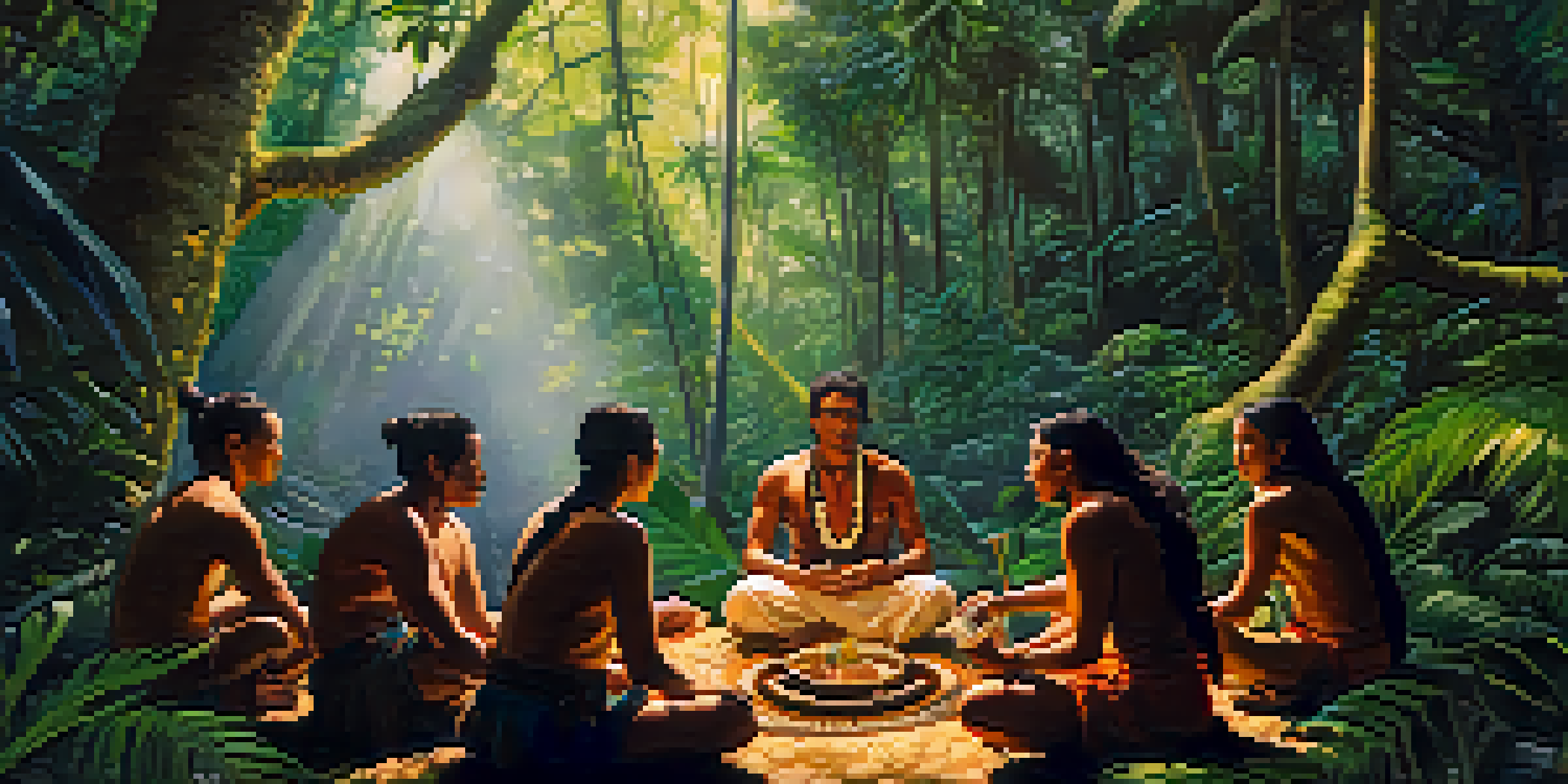Understanding Ayahuasca: Origins and Ritualistic Significance

The Historical Roots of Ayahuasca in Indigenous Cultures
Ayahuasca, a powerful brew made from the Banisteriopsis caapi vine and other plants, has deep historical roots in the Amazon Basin. Indigenous tribes have used it for centuries, both for spiritual and medicinal purposes. The knowledge of its preparation and use is often passed down through generations, weaving the fabric of community and tradition.
Ayahuasca is not just a medicine; it is a teacher that shows us the depths of our souls and the interconnectedness of all life.
The origins of Ayahuasca are intertwined with the beliefs and practices of these cultures, often viewed as a gift from the spirits. Shamans, or spiritual leaders, play a crucial role in the rituals, serving as guides during the Ayahuasca experience. This deep connection to nature and the divine highlights the brew’s significance beyond mere consumption.
Today, as more people become interested in Ayahuasca, understanding its historical context is vital. It reminds us that this experience is not just about personal exploration but also about respecting the rich traditions from which it comes.
The Ingredients: What Makes Up Ayahuasca?
The primary ingredients of Ayahuasca are the Banisteriopsis caapi vine and the leaves of the Psychotria viridis plant, which contains DMT (dimethyltryptamine). When combined, these ingredients create a powerful psychoactive experience. The vine contains harmala alkaloids that inhibit the breakdown of DMT, allowing for its psychoactive effects.

This combination is essential for the Ayahuasca experience, as DMT alone is not orally active. The ritualistic preparation of the brew is often a communal affair, with participants involved in the process to honor the plants and their spirits. This connection to the ingredients enhances the spiritual significance of the experience.
Ayahuasca's Cultural Significance
Ayahuasca is deeply rooted in Indigenous cultures, where it serves both spiritual and medicinal purposes.
Understanding the components of Ayahuasca is crucial for appreciating its effects. Each ingredient contributes not just to the brew's potency but also to the broader cultural and spiritual narrative surrounding its use.
Rituals and Ceremonies: The Ayahuasca Experience
Ayahuasca ceremonies are often held in a ceremonial space, surrounded by nature, and led by an experienced shaman. Participants gather to drink the brew, setting intentions for their journey. The atmosphere is charged with energy, as music and chants, known as ikaros, guide the participants through their experience.
The experience of Ayahuasca is about more than just the brew; it’s about the community, the culture, and the connection to something greater than ourselves.
During the ceremony, participants may encounter visions or deep emotional insights. These experiences can be transformative, providing clarity and healing. The shaman’s role is crucial here; they navigate and support participants through their journeys, ensuring safety and encouraging introspection.
The ritual aspect of Ayahuasca is significant, as it fosters a sense of community and shared experience. This shared journey creates bonds among participants, often leading to lasting connections and a deeper understanding of oneself and others.
The Role of the Shaman in Ayahuasca Rituals
In Ayahuasca ceremonies, the shaman serves as both a guide and protector. Their extensive knowledge of the brew and its effects allows them to navigate the spiritual landscape of the experience. This role is not taken lightly; shamans often undergo years of training and personal journeys to prepare for this responsibility.
The shaman’s presence is vital for creating a safe environment where participants can explore their consciousness. They often use traditional songs and healing techniques to assist individuals in processing their experiences. This connection between the shaman and participants reinforces the communal aspect of the ritual.
Shamans Guide the Experience
Shamans play a crucial role in Ayahuasca ceremonies, providing guidance and support during participants' transformative journeys.
Moreover, the shaman embodies the bridge between the physical and spiritual realms. Their guidance helps participants interpret their visions, integrating insights gained during the experience into their daily lives.
Potential Benefits of Ayahuasca: Healing and Growth
Many participants report profound healing experiences after Ayahuasca ceremonies. These can range from emotional release and trauma processing to increased self-awareness and spiritual growth. For some, Ayahuasca acts as a catalyst for change, encouraging healthier lifestyles and relationships.
Scientific studies are beginning to explore these potential benefits, looking at how Ayahuasca impacts mental health. Preliminary research suggests it may help with conditions like depression, anxiety, and PTSD. However, personal anecdotes often highlight the transformative power of the experience on a spiritual level.
While the potential benefits are significant, it's essential to approach Ayahuasca with respect and caution. It is not a panacea, and experiences can vary widely from person to person, emphasizing the importance of preparation and integration.
Risks and Considerations: A Balanced Perspective
Despite its potential benefits, Ayahuasca is not without risks. Some individuals may experience overwhelming emotions or challenging visions that can be difficult to process. It’s crucial to approach the experience with awareness and to seek guidance from qualified shamans.
Medical conditions and certain medications can interact negatively with the brew, making it essential to disclose any health issues beforehand. This precaution helps ensure safety during the ceremony, allowing participants to focus on their journey without physical concerns.
Benefits and Risks of Ayahuasca
While Ayahuasca can lead to profound healing and self-discovery, it also carries risks that necessitate informed participation.
Ultimately, understanding the risks associated with Ayahuasca is vital for informed decision-making. Balancing excitement for the experience with caution can lead to a more meaningful and safe journey.
Modern Interest in Ayahuasca: A Global Phenomenon
In recent years, Ayahuasca has gained significant popularity outside of indigenous cultures, attracting people from all walks of life. This global interest has sparked a growing number of retreats and ceremonies worldwide, often blending traditional practices with modern wellness trends. However, this commercialization raises important questions about cultural appropriation and sustainability.
As more individuals seek out Ayahuasca for personal growth, it’s vital to approach these experiences with respect for their origins. Understanding the cultural significance behind the rituals can foster a deeper appreciation and encourage responsible tourism. Engaging with local communities and shamans can enhance the experience while supporting indigenous practices.

The modern fascination with Ayahuasca illustrates a broader search for connection, healing, and understanding in today’s fast-paced world. By honoring its roots, participants can contribute to a more respectful and sustainable approach to this ancient practice.